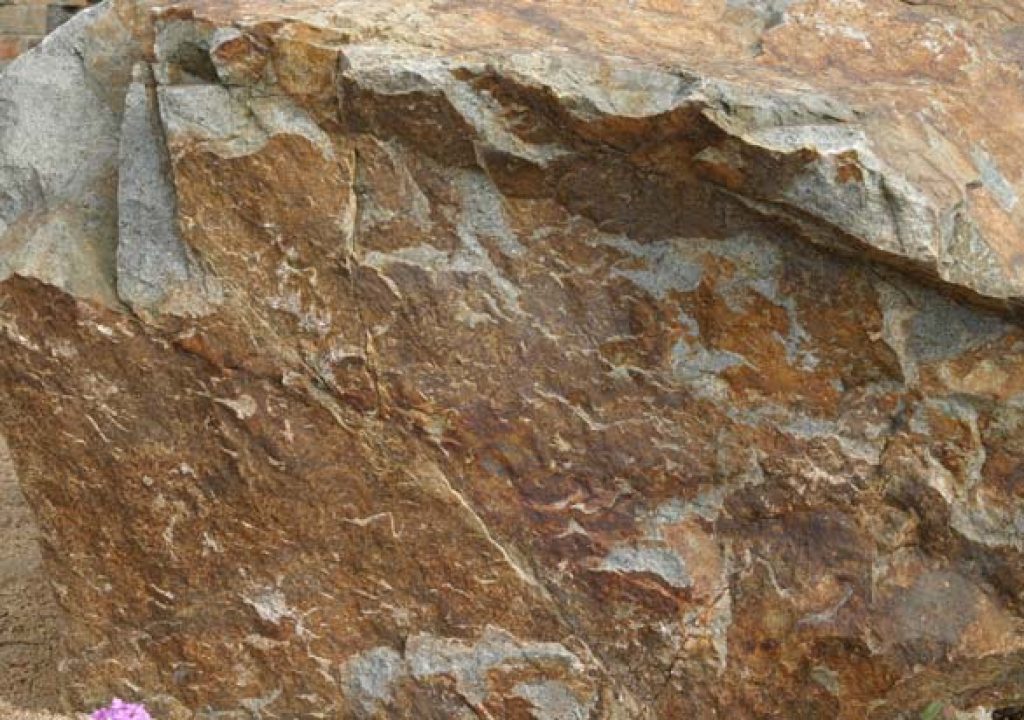The primary reason I agreed to write this Hybrid Artist blog was to share information about using photographs as the basis for creating collages as well as other forms of abstracted art. In that vein, here is a quick blow-by-blow for the latest piece I finished: Avian Aspirations.
A lot of my raw material comes from photographing rocks, particularly close up: I love the veining and textures. Back when a Canon 10D was our main camera, I tried to get close to the final framing when I took the picture, in order to preserve the maximum number of pixels for later printing. (Now that I have a 5D mkII with a lot more pixels, I'm still training myself that it's okay to back up a little and get more of the surrounding, should I want to re-frame the shot later.)
One rich source of inspiration came from a series of landscaping boulders surrounding a timeshare we often used in Palm Desert, California. Here is one of those photos:
Back when I relied on JPEG images from the 10D, I would use the heavy duty video color correction software Color Finesse inside Adobe After Effects (again, a video program; it's our main source of employment) to tease the colors out of the image, including increasing its contrast and saturation. Color Finesse works in floating point internally, so I could get away with a quite a bit before the image would start to posterize; today with the 5D I shoot everything in Camera Raw and tend to use the Raw dialog to at least start out sending the image down the path I want.
Below is the original image after flipping, light cropping, and heavy color correcting:
I then create a very pale version of my image and print it onto a heavy paper stock, such as Hawk Mountain Kestrel. I use this pale image as a sort of paint-by-numbers guide to glue collage papers on top of, tearing different papers to follow the veins in the rock and therefore tint sections differently. For this piece, the white squiggles in the upper right third of the color-corrected image reminded me of rock drawings of birds in flight, so I used this as a leaping-off point for a theme. The resulting paper collage includes silkscreened petroglyphs, stamps depicting both birds and earlier cultures, and an ode to birds by John Ruskin from an old nature book that is now in the public domain:
To make this varied paper collage receptive to inkjet printing, I coated it with Golden Digital Ground and ran it through an old Epson 2200 archival pigment inkjet printer (the paper is 13″x19″; the image is 12″x18″) with a custom color profile. I slightly distressed the surface to make the print a bit less perfect, mounted it on a board, and then selected a variety of themed beads, fibers, and feathers to hang from a quill running across the upper right section of the print. (Indeed, the piece say on my desk unfinished for roughly a year until I could locate “just the right” items to hang from that quill. Artists…) Here is the final piece:
Although I originally framed these pieces behind glass, I now spray a UV protective coating on top and mount them exposed on a panel or in a shadowbox so that the viewer can better see the texture of the collage papers underneath, as well as the assemblage items added on top.
The real underlying point is just as we use darkroom techniques (analog or digital) to enhance an image and take it a place outside reality, you can also use your choice of papers to further take a photo down a path an observer of the original scene could not have imagined – but maybe which you saw in your mind's eye when you took the photo.
Our photographs and artwork, as well as content contained in our books, videos, blogs, and articles for other sites are all copyright Crish Design, except where otherwise attributed. Other examples of my mixed media work may be found on my artist web site.

